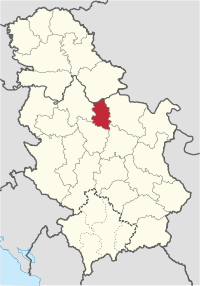Podunavlje District Подунавски округ Podunavski okrug | |
|---|---|
|
Images from the Podunavlje District | |
 Location of the Podunavlje District within Serbia | |
| Coordinates: 44°40′N 20°56′E / 44.667°N 20.933°E | |
| Country | |
| Region | Southern and Eastern Serbia |
| Administrative center | Smederevo |
| Government | |
| • Commissioner | Jasna Avramović |
| Area | |
• Total | 1,248 km2 (482 sq mi) |
| Population (2021 census) | |
• Total | 176,935 |
| • Density | 141.8/km2 (367/sq mi) |
| ISO 3166 code | RS-10 |
| Municipalities | 2 and 1 city |
| Settlements | 58 |
| - Cities and towns | 3 |
| - Villages | 55 |
| Website | www |
The Podunavlje District (Serbian: Подунавски округ, romanized: Podunavski okrug, pronounced [pôdǔnaʋskiː ôkruːɡ]) is one of nine administrative districts of Southern and Eastern Serbia. The district's name refers to its location by—specifically, to the south of—the Danube river. It expands across the central parts of Serbia. According to the 2011 census results, it has a population of 199,395 inhabitants. The administrative center is the city of Smederevo.
Cities and municipalities
[edit]It encompasses the municipalities of:
Demographics
[edit]| Year | Pop. | ±% |
|---|---|---|
| 1948 | 153,039 | — |
| 1953 | 164,975 | +7.8% |
| 1961 | 180,122 | +9.2% |
| 1971 | 197,205 | +9.5% |
| 1981 | 220,425 | +11.8% |
| 1991 | 226,089 | +2.6% |
| 2002 | 209,987 | −7.1% |
| 2011 | 199,395 | −5.0% |
| 2022 | 175,573 | −11.9% |
| Source: [1] | ||
According to the last official census done in 2011, the Podunavlje District has 199,395 inhabitants. 52.09% of the population lives in the urban areas.
Ethnic groups
[edit]Ethnic composition of the district:
| Ethnic group | Population | Percentage |
|---|---|---|
| Serbs | 188,641 | 94,61% |
| Romani | 3,312 | 1,66% |
| Macedonians | 449 | 0,23% |
| Montenegrins | 414 | 0,21% |
| Croats | 256 | 0,13% |
| Yugoslavs | 182 | 0,09% |
| Hungarians | 159 | 0,08% |
| Others | 5,982 | 3,00% |
| Total | 199,395 | 100,00% |
History and culture
[edit]Smederevo was the capital of the Serb State in the fourteenth century - there stood the royal palace at the time of the then Serbian ruler Đurađ Branković. Today, in the remnants of the Smederevo fortress, finished in 1430, traces of the former palace, chapel, and the house of the royal family can be discerned. At the old city cemetery stands a church from the fourteenth century, assumed to have been the family vault of the Serb ruler Đurađ Branković, which gave rise to numerous legends.
This area is also well known as the place of the Karađorđe's assassination after The First Serbian Uprising around the Pokajnica monastery near Velika Plana.
Settlements
[edit]

This is a list of the settlements in the Podunavlje District:
- Azanja
- Badljevica
- Baničina
- Bačinac
- Bašin
- Binovac
- Cerovac
- Dobri Do
- Drugovac
- Glibovac
- Golobok
- Grčac
- Kolari
- Krnjevo
- Kulič
- Kusadak
- Landol
- Lipe
- Lozovik
- Lugavčina
- Mala Krsna
- Mala Plana
- Malo Orašje
- Markovac
- Mihajlovac
- Miloševac
- Mramorac
- Novo Selo
- Orešac
- Osipaonica
- Petrijevo
- Pridvorice
- Radinac
- Rakinac
- Ralja
- Ratari
- Saraorci
- Selevac
- Seone
- Skobalj
- Smederevo
- Smederevska Palanka
- Staro selo
- Stojačak
- Suvodol
- Udovice
- Veliko Orašje
- Velika Plana
- Vlaški Do
- Vodanj
- Vodice
- Vranovo
- Vrbovac
- Vučak
- Šalinac
See also
[edit]References
[edit]- ^ "2011 Census of Population, Households and Dwellings in the Republic of Serbia" (PDF). stat.gov.rs. Statistical Office of the Republic of Serbia. Retrieved 11 January 2017.
Note: All official material made by Government of Serbia is public by law. Information was taken from official website.












